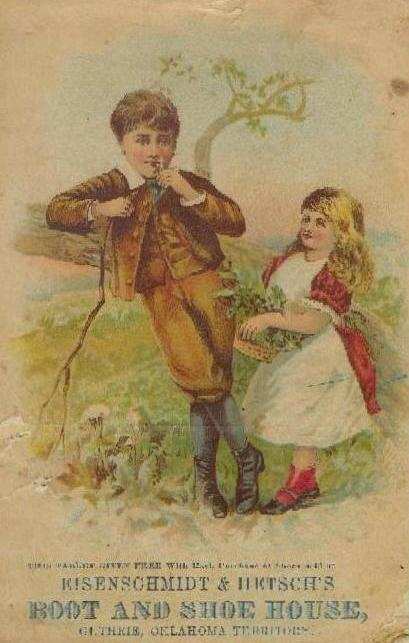
Retail Stores Handling Boys' Clothing: Eisenschmidt & Hetsch's Boot and Shoe House (United States)

Figure 1.-- Here we have a look at the Oklahoma Territory before Oklahoma became a state in 1907. We have a tablet cover that the store gave out to customers. We have no idea when it was printed, but as it is in color it would have to be in the late 19th century, possibly the very early 20th century. Eisenschmidt & Hetsch's Boot and Shoe House was located in Guthrie, Oklahoma Territory.
|
Here we have a look at the Oklahoma Territory before Oklahoma became a state in 1907. We have a tablet cover that the store gave out to customers. The small print is difficult to read, but says something like "This tablet given free with each purchase of shoes at ???".
We have only a rough idea when it was printed. As it is in color it would have to be in the late 19th century, possibly the very early 20th century. The Oklahoma Territory was not organized until 1890, so the tablet had to be printed between 1890 and 1907. Eisenschmidt & Hetsch's Boot and Shoe House was located in Guthrie, Oklahoma Territory. This is probably a good example of a shoe store in Western states and territories during the late 19th century. Unfortunately we do not know aything else about the store. The tablet is an interesting item of late-19th century advertising. There is a Victorian Era picture of a boy and girl on the cover. Measures 5 1/2" X 8 3/4". The illustration can not be taken literaly. This was an artistic creation rather than an accurate depiction. My guess is that the illustration was printed by a company marketing these items nation wide and stores could pay to have their name added at the bottom. Thus the tablet does not depuct Oklahoma Terriory children like a photographic portrait would. This probablt tells us more about period advertising than the actual store. We think for example that boys at the time were probably more likely to wear kneepants than knickers and in the Oklahoma Territory during the 19th century, long pants were probably more common. Mothers would have probably seen the outfits as stylish rather than a depiction of the clothes commonly worn by boys. The color choices for the clothing is probably reasonably accurate--perhaps a little brighter than actual clothes. The color choices probably were chosen to be eye-cathing more than accurate. Another interesting aspect of the page here is the names of the owners--Eisenschmidt & Hetsch. These are both German names. Many Germans who emmigrated to America in the 19th century turned to retailing. This is a good example.
HBC

Navigate the Boys' Historical Clothing catalog/magazine pages:
[Return to the Main individual A-L retail store page]
[Fashion magazines and store page]
[Main photo/publishing page]
[Fashion magazines]
Navigate the Boys' Historical Clothing Web Site:
[Return to 19th century advertising]
[Return to German immigration]
[Introduction]
[Activities]
[Biographies]
[Chronology]
[Clothing styles]
[Countries]
[Bibliographies]
[Contributions]
[FAQs]
[Glossaries]
[Satellite sites]
[Boys' Clothing Home]
Navigate the Boys' Historical Clothing Web Site:
[Sailor hats]
[Flat caps]
[Buster Brown suits]
[Eton suits]
[Rompers]
[Sailor suits]
[Tunics]
[Smocks]
[Knickers]
[Pinafores]
[Long stockings]
[Underwear]
Created: 8:26 PM 12/15/2005
Last updated: 8:26 PM 12/15/2005



